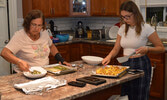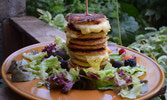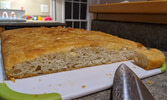Farms to Tables - The Citizen's annual 100K Meal is back
You’re reading The Citizen’s annual Huron Farms to Tables sections and that can only mean one thing - the return of the ever-popular Citizen 100-kilometre meal! Members of the staff (or their spouses) have slaved away for hours to bring you these meals, so you better enjoy them.
This year, we’ve gone with an appetizer, dinner and dessert. And, if you’ve read your Bible recently, you know there’s only one way to begin a supper, last or otherwise: bread! Bonus recipe!
Let’s do it.
- SL
Bread goes with everything: Ligurian focaccia by Shawn Loughlin
For the bread, you can make a relatively simple focaccia with your 100-kilometre ingredients, courtesy of celebrated chef Samin Nosrat, the author of Salt Fat Acid Heat.
She relayed a recipe for Ligurian focaccia from locals in the northern tip of Italy, which includes over 12 hours of fermentation.
At least 14 hours before you hope to be eating bread, mix five-and-a-third cups of flour with two tablespoons of salt, adding two-and-a-half cups of warm water with a half-teaspoon of yeast (not local, I’m afraid) with two-and-a-half teaspoons of honey. Then, add a quarter-cup of olive oil (the flavour will really come through, so use the best olive oil you can find, perhaps from the Southampton Olive Oil Company or Olive Your Favourites in Stratford).
Let the dough ferment at room temperature in a large bowl (the dough will at least double in size), covered in cling wrap for between 12 and 14 hours.
Oil a baking sheet and gently release the dough onto the sheet, doing your best to agitate it as little as possible (the air bubbles are crucial to the fluffiness of the bread). Pour some more olive oil on top of the dough, spreading it out to the edges of the tray a few times over 30 minutes.
Create some dimples on the top surface of the bread and completely cover the bread with a brine made of a third-cup of warm water and one-and-a-half teaspoons of salt, which creates a pleasant saltiness throughout the entire loaf. Add a few more drops of olive oil alongside the brine and allow the bread to proof for another 45 minutes.
Sprinkle some delightful flaky sea salt on top of the dough (not local, but the Newfoundland Salt Company makes some top-notch sea salt; Jacobsen Salt Company makes delightful flaky sea salt in Oregon as well, if you’re into paying a lot in import fees into Canada - and who isn’t?) and put it in an oven heated to 450°F for between 25 and 30 minutes. Nosrat’s instructions include using either a baking stone or an inverted baking sheet in the oven, so it can get super hot and blast the bottom of the bread with heat.
Finish the bread on the top rack of the oven for another five to seven minutes and then remove it, then add a few more tablespoons of oil onto the bread as it cools (the bread will absorb the oil). Let it finish on a cooling rack.
Start me up: grilled cheese sandwiches by Scott Stephenson
The idea of the 100-kilometre meal was originally put forth as a sort of challenge, designed to illustrate how complex the modern day food web truly is.
There are those living in urban areas and other food deserts that really have to wrack their brains when it comes to creating such a meal. But here in Huron County, we basically have our pick when it comes to making a meal entirely out of locally-sourced ingredients. This is a place that, historically, has produced a plethora of produce, filled trains with grain and raised meat that just can’t be beat. So, if you’re living in the area, being challenged to make a single appetizer using only ingredients found within a 100-kilometre radius of the office is only really challenging when it comes to choosing just one appetizer to make. In terms of canapés alone, there are near infinite options when it comes to bread/topping combos. Don’t even get me started on the possible amuse-bouche options available county-wide - it’s unfathomable. The mind boggles at the sheer number of amuse-bouche possibilities.
When one is fully overwhelmed with the possibility of potential food stuffs, it’s always best to step back and take a moment to consider not what you could do, but what you want to do. And in this case, a moment of quiet contemplation revealed that all signs were pointing in the same direction - towards classic grilled cheese sandwiches.
Right now, you might be thinking to yourself, “a classic grilled cheese sandwich is not an appetizer.” And you’re right. When you see grilled cheese sandwiches being passed around at a party, they are always, in some way, fancied up. Maybe they have some kind of exotic ham hiding inside them, or a drizzle of blackberry balsamic, or some other such bell or whistle that is supposed to somehow elevate the already noble grilled cheese. But we all know that one of those tiny, precious sandwiches isn’t really a grilled cheese. A real grilled cheese is a three-ingredient sandwich, straight up. If you choose to integrate any ketchup into the situation after the sandwich has already been constructed, well, that’s between you and yours.
Of course, choosing the classic grilled cheese sandwich as your go-to party appetizer requires a fair amount of confidence, and that confidence can only come from using absolutely top quality ingredients. Luckily, all three of the essential (and only) ingredients of a grilled cheese are made in Huron County. St. Brigid’s Creamery in Brussels produces some of the nation’s best grass-fed butter, and nearby Capella Meadows is a great source of fresh goat milk, cheddar and feta. Make the long trip to Red Cat Bakery all the way out Goderich-way, and you’ll have the perfect loaf of challah-style bread, although any bread from Red Cat will work.
Use an overturned glass or cookie cutter to cut the bread into perfect circles, butter each round liberally, shred up your goat cheddar, crumble in a little of that briny feta, and proceed making one perfectly golden brown sandwich at a time, keeping them warm as you go in the oven. When it’s time to serve your grilled cheese sandwiches, add some class by stacking your sandwiches sky high, impaling them on a long skewer if deemed necessary for stability. Surround with an unnecessary salad of garden greens and seasonal berries, and voila - it’s party time!
Dinner bell’s ringing: Italian chicken cutlets with zucchini caponata, roast potatoes and Parmesan asparagus for four by Maria and John Stephenson
For the zucchini caponata, chop a red and green bell pepper into two- or three-inch pieces, a tomato into small pieces, a large onion into slivers, two small zucchini into quarter-inch slices and a cup of mushrooms into small pieces. Press two cloves of garlic and you’re ready to go.
In a large, deep skillet, pour approximately a half-cup of olive oil into skillet - just enough to cover the bottom of the skillet. Sauté the onions and garlic until the oil is hot - about a minute or so.
Add all the chopped vegetables and stir all together until the vegetables are mixed with the oil. Add about a cup of cool water and stir again. Cook on high heat for about 10 to 15 minutes, stirring frequently.
Reduce heat to medium-low and cover with a lid, stirring occasionally. Do not let the veggies get dry or burn. If more water is required add about a half-cup of water at a time. Cook until veggies are soft but not mushy. This caponata is great served over rice.
For the roast potatoes, you’ll need four large yellow-fleshed potatoes, peeled and chopped into chunks. Drizzle them with olive oil and salt and pepper to taste, in addition to your favourite seasoning (a Stephenson favourite is flaked thyme).
Place the potatoes on a baking sheet and roast at 350°F for between 30 and 45 minutes, turning the potatoes halfway through roasting.
To make the parmesan asparagus, place the washed asparagus on a small baking sheet, covered with aluminum foil. Drizzle them lightly with olive oil and season to taste with salt and pepper. Sprinkle a few tablespoons of cheese over the asparagus, cover with aluminum foil and bake at 350°F for 30 minutes.
Now, onto the main event. You’ll need four boneless chicken breasts to make the chicken cutlets. Slice them in half, horizontally, and set them aside.
In a large mixing bowl, beat three eggs well and add a quarter-cup of milk and about three tablespoons of parmesan cheese and some salt and pepper, whisking them together well.
Place the chicken breasts in the mixture and let them sit for about 30 minutes.
Now, it’s time to get messy. Place two or three cups of unseasoned bread crumbs in a large, flat dish and take one slice of chicken breast and coat with the bread crumbs by laying it flat on the bread crumbs and then turning it over and patting it flat into the bread crumbs with the palm of your hand, do this a couple of times by flipping it over.
Remove the chicken from the bread crumbs and place flat on a dish. Repeat this process until all the chicken is coated with the bread crumbs. Set aside.
In a large frying pan, fill halfway with vegetable oil (not canola or safflower oil, as it will not taste the same).
Heat oil on full until hot. Reduce heat to three quarters or so. Place chicken slices in hot oil very gently, do not overcrowd. Fry until golden brown, flipping them over a couple of times with tongs. When golden, remove from oil and place on a plate covered with paper towel to soak up the excess oil.
Repeat process until all breasts are golden.
A cheesy conclusion: baked cheesecake by Shawn Loughlin
This one gets a little dicey with 100-kilometre ingredients and calls on you to make your own cream cheese if you can’t find it locally, but it’s worth it. It’s a loving homage to a recipe found in Earth to Table Bakes from the Guelph-based restaurant now known as Bardo, written by Erin Schiestel and Bettina Schormann - go eat there if you haven’t already. (A fun fact for long-time Citizen readers is that former Citizen photographer Jasmine deBoer worked on the creation of the aforementioned book. Proud of you, Jasmine! Taught her everything she knows!)
Mix together two cups of ground graham crackers, a half-cup of brown sugar, a teaspoon each of cinnamon and kosher salt and a half-cup of unsalted butter to make the crust. Pack it down into the base of a well-greased 10-inch springform pan.
For the cake filling, mix together 24 ounces of cream cheese (three packages if you don’t make it yourself - if you do, you’re amazing; there are many recipes online on how to do this), two cups of sugar, one tablespoon of pure vanilla extract, a quarter-cup of flour, four large eggs, two large egg yolks and a half-cup of whole milk.
If you have a stand mixer, use the paddle attachment. If you don’t, just as I don’t, I hope you’ve been hitting the gym. Stir the cream cheese and sugar first, fully incorporate, then the vanilla, then the flour, then the eggs and then the milk. Once everything is fully combined, pour it over the crust and bake at 250°F. The written recipe says for 90 minutes, but I’ve found I’ve had to go for nearly two hours with my oven. (It should no longer look wet when you take it out and should only jiggle slightly.)
Place the cake on a wire rack, leaving the pan bottom on, to cool to room temperature. Then put the cake in the fridge for at least three hours before serving.
The Bardo recipe calls for a rhubarb compote to be served atop the cake, but any seasonal, Huron County-grown fruit would do - I’m thinking strawberries here. If you’re lazy, a can of cherry or blueberry pie filling does the trick, though I will say it is delightful on its own, naked as the day it was baked.




